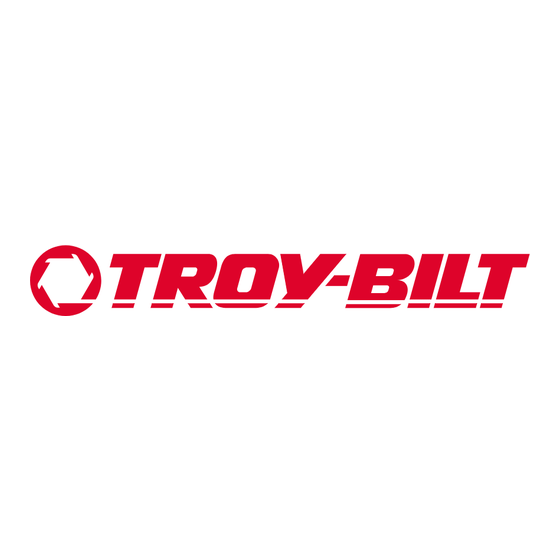Table of Contents
Advertisement
IMPORTANT: READ SAFETY RULES AND INSTRUCTIONS CAREFULLY
WARNING:
This unit is equipped with an internal combustion engine and should not be used on or near any unimproved forest-covered, brush-covered or
grass-covered land unless the engine's exhaust system is equipped with a spark arrester meeting applicable local or state laws (if any). If a spark arrester is used, it
should be maintained in effective working order by the operator. In the State of California the above is required by law (Section 4442 of the California Public
Resources Code). Other states may have similar laws. Federal laws apply on federal lands. A spark arrester for the muffler is available through your nearest engine
authorized service dealer or contact the service department, P.O. Box 361131 Cleveland, Ohio 44136-0019.
TROY-BILT LLC, P.O. BOX 361131 CLEVELAND, OHIO 44136-0019
PRINTED IN U.S.A.
Operator's Manual
Two-Stage Snow Thrower
8526—Storm
9528—Storm
FORM NO. 769-01279A.fm
(7/30/2004)
Advertisement
Table of Contents

Summarization of Contents
Important Safe Operation Practices
Training
Read and follow all instructions before operating. Keep manual for reference.
Preparation
Inspect area, wear safety gear, use proper clothing and footwear.
Operation
Instructions for safe use, including handling controls, moving, and stopping the machine.
Maintenance and Storage
Procedures for upkeep, cleaning, and storing the snow thrower to ensure longevity and safety.
Your Responsibility
User's obligations and restrictions for safe operation of the snow thrower.
Safety Labels
Identification and explanation of critical safety labels found on the snow thrower.
Know Your Snow Thrower
Shift Lever
Description of the shift lever and its positions for forward and reverse speeds.
Gas Cap
Location and function of the gas cap for refueling the engine.
Choke Control
How to use the choke control for cold-weather engine starting.
Throttle Control
Function of the throttle control for engine speed and shutdown.
Primer
Using the primer to aid in cold-weather engine starting.
Oil Fill
Location for checking and adding engine oil.
Auger Control
How to engage and disengage the augers for snow throwing.
Drive Control
How to engage and disengage the wheel drive for propulsion.
Chute Directional Control
Adjusting the chute direction and angle for snow discharge.
Ignition Key
Function and usage of the ignition key for starting and stopping the engine.
Clean-Out Tool
Purpose and use of the clean-out tool for unclogging the chute.
Skid Shoes
Adjusting skid shoes for different surface conditions.
Recoil Starter Handle
Using the recoil starter handle to manually start the engine.
Electric Starter Button
Using the electric starter button to start the engine.
Electric Starter Outlet
Requirements for using the electric starter outlet.
Augers
How augers function to draw snow into the housing.
Chute Assembly
How snow is discharged from the auger housing.
Spark Plug Cover
Accessing the spark plug by removing the cover.
Operating Your Snow Thrower
Before Starting
Essential checks and preparations before operating the snow thrower.
Gas and Oil Fill-Up
Instructions for safely filling the engine with gasoline and oil.
Starting the Engine
Step-by-step guide for starting the snow thrower engine using various methods.
Electric Starter
Detailed instructions and safety precautions for using the electric starter.
Recoil Starter
Instructions for starting the engine using the recoil starter handle.
Stopping the Engine
Procedures for safely stopping the snow thrower engine and preparing for storage.
Engaging the Drive
How to engage the drive system for snow thrower propulsion.
Engaging the Augers
How to engage the augers to start the snow throwing process.
Auger Control Test
Procedure to test and adjust the auger control for proper safety and operation.
Drive and Auger Lock
Using the drive/auger lock for one-handed operation.
Operating Tips
Advice for efficient and safe operation, including warm-up and cleaning.
Chute Clean-Out Tool
How to safely use the clean-out tool to clear a clogged chute.
Making Adjustments
Shift Rod Adjustment
Adjusting the shift rod to ensure full range of speeds.
Auger Control Adjustment
Referencing the Auger Control Test for adjustment procedures.
Tire Pressure
Checking and adjusting tire pressure for optimal performance and wear.
Drive Control Adjustment
Testing and adjusting the drive control cable for proper operation.
Skid Shoes Adjustment
Adjusting skid shoes for different snow and surface conditions.
Joy-Stick Cable Adjustment
Adjusting cables for full range of motion in chute controls.
Maintaining and Servicing Your Snow Thrower
Engine Maintenance
Refer to separate manual for engine maintenance and lubrication.
Lubrication
Lubrication points and procedures for various snow thrower components.
Gear Shaft Lubrication
Lubricating the gear shaft for proper operation.
Wheel Maintenance
Cleaning and lubricating wheel axles.
Chute Directional Control Lubrication
Lubricating the joystick for chute control.
Auger Shaft Maintenance
Lubricating the auger shaft and grease fittings.
Gear Case Lubrication
Lubricating the gear case through the grease fitting.
Shave Plate and Skid Shoes
Checking and replacing wear items like shave plate and skid shoes.
Auger Belt Replacement
Step-by-step guide for removing and installing the auger belt.
Drive Belt Replacement
Instructions for removing and replacing the drive belt.
Friction Wheel Removal
Procedure for removing and replacing the friction wheel assembly or rubber ring.
Off-Season Storage
Auger Shear Pins
Information on auger shear pins, their function, and replacement.
Off-Season Storage Preparation
Steps to prepare the snow thrower for long-term storage to prevent damage.
Manufacturer's Limited Warranty
How to Obtain Service
Procedure for obtaining warranty service, including contact information.
Warranty Exclusions
Cases and conditions not covered by the limited warranty.
Local Laws and Warranty
How local laws affect warranty rights and coverage.














Need help?
Do you have a question about the 9528 and is the answer not in the manual?
Questions and answers